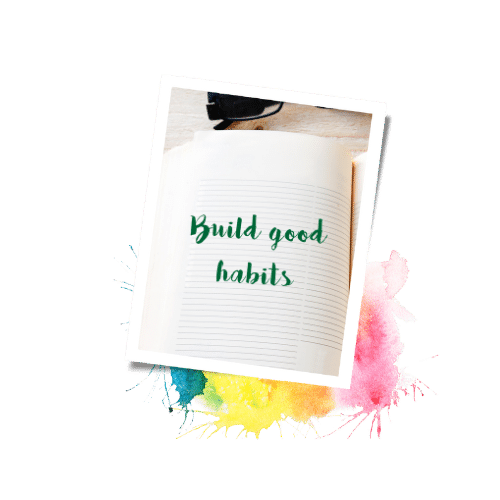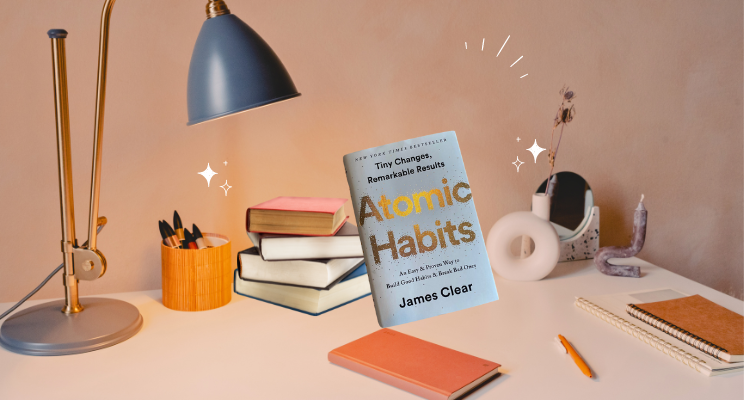Table of Contents
ToggleCan you believe it? It’s already December. With that comes a frenzy of holiday shopping, a slew of reunions with coworkers and old friends, and potentially a string of looming thoughts about the year to come. We get it. With all the excitement and good cheer, one could still get overwhelmed and start ruminating over all the things that could have been. Never fear, we’re here to talk about James Clear’s, Atomic Habits: An Easy & Proven Way to Build Good Habits & Break Bad Ones.
In this blog post, we’ll be giving you a snapshot of Clear’s four laws to help you get your head in the game, now. When the new year comes around, you’ll already be moving one step closer to the person you aspire to be.
A New Way of Thinking
What makes Clear’s book so fascinating is that he provides you with an unconventional way of building good habits (and reducing bad habits). It’s obvious to us that change takes time. Or else, why would there be tons of motivational books and quotes flooding our newsfeeds. To help us visualize the impact of our small changes, he tells us to imagine an ice cube sitting at 25 *F. With each degree change, not much happens. However, once the temperature reaches to 32*F, it melts. Even though we cannot see it, every step we take moves us towards or away from our goals.
Clear also teaches us that we should focus on the processes we leverage to achieve our goals instead of our goals themselves. For the agilist out there, does this concept ring a bell? (Hint: do you recall the Scaled Agile Framework Principle #2: Apply systems thinking?) One of the many problems of focusing on a goal is that once we achieve it, we have a tendency to revert back to our old, bad habits.
In my case, after completing my first Duathlon back in August, my Strava has completely flatlined. Instead of focusing on my goal of finishing my race, I should have been putting in effort to build my system, which could include how often I should workout, how I would handle plateaus, or how often I should take time for rest and recovery.
Lastly, Clear brings forth the idea of having identity-based habits over outcome-based habits. He provides us with an example of a smoker who is trying to quit. When offered a cigarette, there’s a profound difference in response #1) No thanks, I’m trying to quit vs. response #) No thanks, I’m not a smoker.
The reason why some folks fail to achieve their goals is that although they have changed their behaviors, they haven’t changed their identity– something that we hold dear. This dissonance may cause us to relapse to our bad behaviors. As we strive to build good habits and eliminate bad habits, we need to pivot our identities, too.
To do this, he has a two-step process.
- Decide the type of person you want to be.
- Prove it to yourself with small wins.
In my case, I want to be an athlete. By reshaping our thinking and formulating atomic habits–regular practices or routines that are not only small and easy to do, but also the source of incredible power– we will be on our way to reaching our goals and beyond.
In the following sections, I’ll first focus on how you can apply Clear’s four laws to build good habits.
Law #1: Make It Obvious
The first step of any habit-building is to make it obvious. One method Clear shares is called Pointing-and-Calling, which is leveraged by the Japanese railway system. By calling out all the things you do in a day, you can start to identify things you can adjust.
From there, you can make your habits more obvious by using the cues of time and location. To emphasize cues related to time, you can use Habit Stacking, where you pair a new habit with an existing habit. For me, whenever I am out of water, I do five squats [new habit] before I go downstairs to refill my cup [old habit].

For cues related to location, you can look at ways you can enhance your environment. Clear mentioned a case where a physician at Massachusetts General Hospital in Boston rearranged a cafeteria by adding more water bottle stations. As a result, the sale of water increased by 25.8%, while the sale of soda reduced by 11.4%. An individual person didn’t have to make any adjustments on how they ate. Water was just more available, so it became easier to choose it over soda.
Law #2: Make it Attractive

For this second law, Clear explains the power of dopamine, our neurotransmitter involved in our motivation. We actually get more excited in the anticipation of our reward than the reward itself. As a result, we could use temptation bundling, where we stack a habit we want with a habit we need. For me, after I pull out a bag of chips, I will write one paragraph. After I write one paragraph, I will eat the chips! By using this tactic, I begin associating writing with the same feeling of excitement I get when I get my hands on a bag of chips.
Secondly, you can also surround yourself with like-minded people. Clear talks about a Hungarian man named Laszlo who aspired to raise chess masterminds. As a result, Laszlo found a partner that shares his values and created a family that rewarded a love of chess. When asking his daughters if they disliked the environment that they grew up in, they said that they couldn’t get enough of the sport.
In conclusion, social norms play a huge role in our behaviors whether we like it or not. Therefore, we should use them to our advantage. Haven’t you just felt more empowered to do that extra rep at the gym versus when you’re at home? In my case, does anyone know of any Swiftie Workout Meetups in the Bay Area? Please send them my way.
Law #3: Make it Easy
Since habit formation is a journey, Clear introduces his third law, making it easy. The problem with building good habits is that it’s not about how long we’ve been practicing the new behavior, but instead the number of times we actually practiced the habit in a given time. Therefore, our new habits should be executed as easily as possible.
One thing to consider is how you can reduce the friction surrounding habits you want to form. Being an athlete, I lay out my workout clothes in the morning and keep my running shoes by the door instead of in the closet. Another practice is priming your environment. Have you ever been in a situation where you had every intention to eat a salad for lunch, but caved in and ordered Doordash? To combat this, you can prepare meals for the week and have your fixings ready for your salad so that the easy choice is something that is already ready to go.

Another practice you can do is perform one time actions that lock in good habits. In his book, Clear speaks about John Henry Patterson, a manager of a supply store that was facing a problem of employee theft. To curb it, he leveraged Ritty’s Incorruptible Cashier that locked the register after every transaction. By investing technology that automated ethical behavior, Patterson went from losing money to making a profit! For example, if you’re trying to save money, you could unsubscribe from promotions or create automation rules in your inbox that automatically move offers to a hidden folder.
If those don’t work, Clear has a two-minute rule, when you start a new habit, it should take less than two minutes to do. As I add strength training into my routine, what I can start with is just doing one rep each day. What this rule forces me to do is to show up. Each time I show up, I up my practice count, which helps my habits settle in a little bit more.
Law #4: Make it Satisfying

For this final law, it’s all about ensuring that we keep on making the changes we need to reach our goals. With the rise of mobile gaming and social media, we have become a society of instant gratification. Therefore, the fourth law is all about using that to our advantage.
To open this section, Clear shares a story on how a public health worker named Stephen Luby drastically reduced health incidents of children in Karachi, Pakistan by introducing a soap that people loved to use. Safeguard was a soap that was super sudsy and smelled great. Whenever they used it, they were immediately rewarded by its scent and the feeling of cleanliness from the suds.
To leverage instant gratification, you can incorporate small wins through strategies like habit tracking. For me, I get a little thrill every time I check another day off on my calendar whenever I workout or cross off something from my to do list. Another tactic is rewarding yourself when you did nothing. In my case, every time I don’t spend $5 on a new bag of Kirkland Signature Kettle Chips, I can put $5 towards my vacation budget.
And finally, we are all human, and we will miss a day. The all-or-nothing mentality will derail our journey towards our goal. Clear’s only suggestion is that if this happens, we don’t miss it twice. In the end, do what makes sense to you as long as you’re putting in “practice” every moment you get.
And, what about bad habits?
When it comes to bad habits, you take the antonym of Clear’s laws. Instead of making it obvious, you make it invisible. As an athlete, it’s important that I maintain a healthy diet. As a result, I have either hidden or stopped buying potato chips, my guilty pleasure. I have also modified my environment by deeming my office as a no eating zone to reduce snacking.
Instead of making it easy, you make it difficult. As a result, I sometimes put my chip bags on the highest shelf of my pantry. In order to get it, I have to use a step ladder that is in the garage. The more steps and barriers you implement, the better chances you have of reducing that habit. You get the picture? All you have to do is take each law, flip it, and stick to it to eliminate a bad habit.
In Conclusion
As Clear mentioned, there’s no need to make great leaps to your routines now. It’s all about starting small. As I wrote this post, I told myself “Cassandra, you just need to write 250 words today and then, another 250 tomorrow. By day four, you will have written 1000 words and you can call it a day!”
Therefore, do what you can today. Tweak something about your environment. Spend one minute reflecting on who you want to be. Whatever it is, choose something that you can digest. In fact, we might even recommend that you find something that is small enough that you would call it bite size.
Identify as a lifelong learner & coach? Here are a few posts you can check out: Tribal Unity Book Review, Trick or Treat: Facilitator’s Edition, and Collaborate with Mural,

Pingback: For Auld Lang Syne | What We Learn In Life | InBiteSize